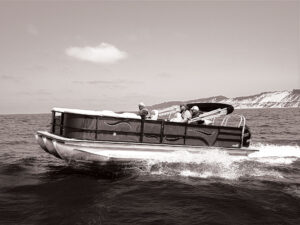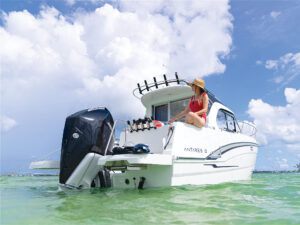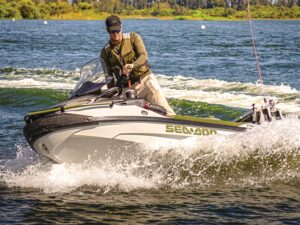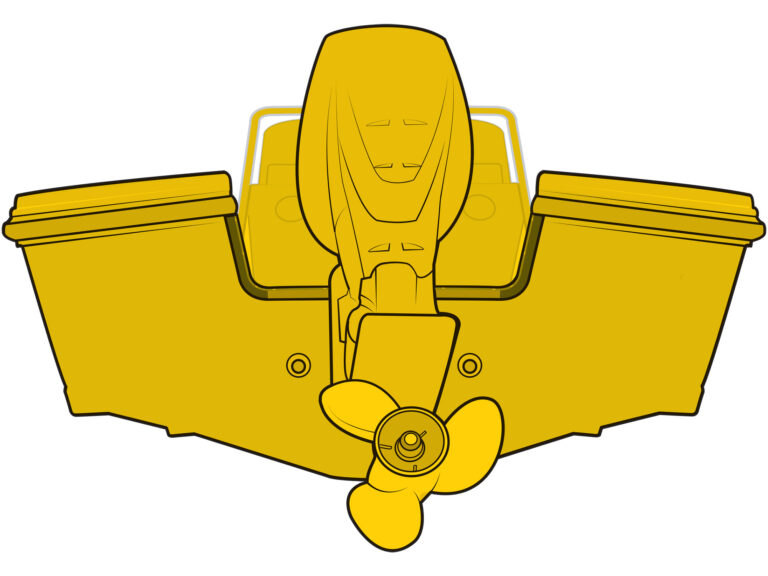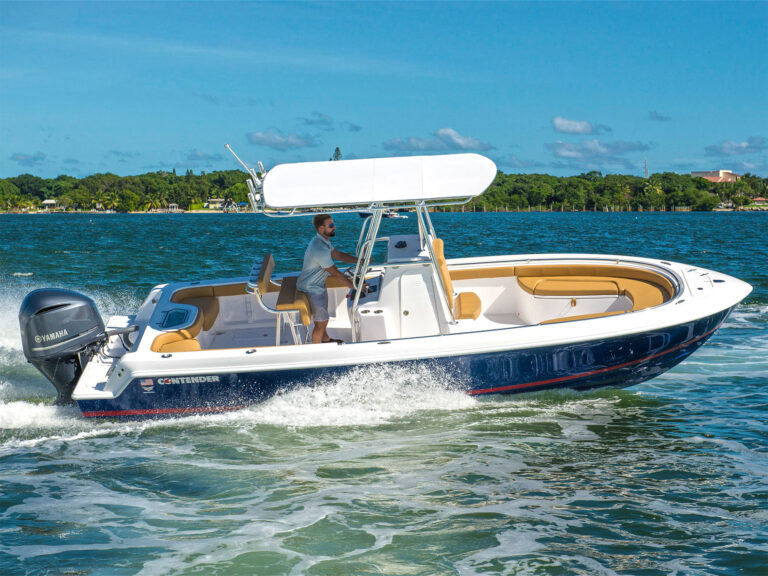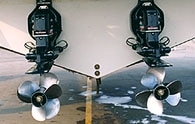
To V Or Not To V
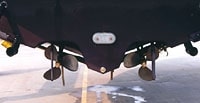
To V Or Not To V
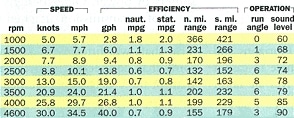
260-hp V-drive

To V Or Not To V
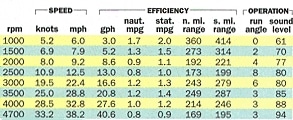
300-hp V-drive
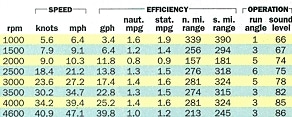
260-hp Stern Drive

To V Or Not To V

To V Or Not To V
Lately, there’s been a tricky choice facing anyone buying a fishboat or cruiser in the 28′ to 34′ range – a choice that stumps even the pros. With so many boats being offered with the new-generation V-drives, is there any reason to still consider an I/O?
You hear that stern drives are faster. But how can they be with more gears eating up power? Also, aren’t stern drives less durable in salt water? And what about fuel consumption, which directly affects range – something of more importance to a cruiser or offshore fisherman than pure speed.
Like you, we’ve had the same questions, but no clear-cut answers. That is, until Sea Ray gave us the chance to uncover the truth. The company recently added a V-drive option to its 290 Amberjack, a versatile boat that can be set up for both cruising and fishing. Originally offered only with stern drives, the V-drive model gave us the perfect opportunity to put the two propulsion systems to a head-to-head test.
We ran three 290 Amberjacks on the same day at the Sea Ray facilities in Knoxville, Tennessee, to ensure similar conditions. The stern drive boat was powered with twin 260-hp Mer-Cruiser 5.7L EFI Bravo Threes, which Sea Ray tells us is one of its more popular I/O packages. To match the stern drive’s power, the second boat had twin 260-hp MerCruiser 5.7L (carbureted) engines coupled with ZF 63-IV V-drives. The third boat, with a pair of 300-hp 350 MerCruiser MAG MPI Horizons and ZF 63-IV V-drives, was there in case it turned out that stern drives are faster than V-drives for the same horsepower.
GEAR HEADS
V-drives still get a bad rap for what they used to be – gear-mashing consumers of power. Older designs consisted of a transmission attached to an engine’s bell housing by a short shaft. This shaft was fitted with a universal joint that connected it to the input shaft of the V-drive. This meshed with the output gear on the end of the propshaft. The design was highly inefficient. But today’s integrated V-drive units, such as the ZF units on our Amberjacks, have the transmission and gears in the same housing and let a lot more power reach the prop.
Theoretically, a stern drive, which redirects the power through two right angles, should be less efficient than a V-drive, which reroutes the power only once. A stern drive connects to the engine’s flywheel with a short splined shaft that has a universal joint at its end. This lets you raise or lower the drive. Within the drive there is an upper horizontal shaft that has gears linked with those on a vertical shaft. Then the gears at the bottom of the vertical shaft connect to the horizontal propeller shaft. A stern drive loses about 13 percent of its power compared to 8 percent for the V-drive, according to Daniel Clarkston, director of product engineering at Mercury Marine’s MerCruiser division. So we wondered if the V-drives might do pretty well in terms of speed and fuel consumption.
NUMBER RUNNER
We had to settle it right from the start. Everyone wanted to know if stern drives are faster. And, for once, the boatyard rumors were right – stern drives fly. The 260-hp stern drive boat ran 47.1 mph at 4600 rpm, while the 260-hp V-drive hit only 34.5 mph. No one expected that much of a difference. The 300-hp V-drive did a little better at 38.2 mph.
CERTIFIED TEST RESULTS: 260-hp V-drive. Advertised fuel capacity 230 gallons. Range based on 90 percent of that figure. Performance measured with two persons aboard, half fuel, no water. Sound levels measured at helm, in dB-A.
TEST POWER: Twin 260-hp MerCruiser 5.7L V-8 gasoline inboards with 350 cid, 4.00″ bore x 3.48″ stroke, swinging ****
PRICE: $124,080 Of more real-world importance on a boat like the 290 Amberjack is fuel consumption. At wide open throttle it was about the same for all three boats. But when comparing fuel consumption at the same speeds, the stern drives again had a decided advantage. The stern drive ran 34.7 mph at 3500 rpm, pretty much the same as the 260-hp V-drive’s 34.5-mph top speed. In terms of fuel consumption, the stern drives burned only 22.8 gph at 3500 rpm versus the V-drive’s 40 gph at WOT. At 4000 rpm the stern drive boat hit 39.4 mph and consumed 25.2 gph – about 1 mph faster than the 300-hp V-drive’s top end, which ate 40.6 gph at the same rpm. Those numbers equal big advantages in speed and economy. And the advantage goes to the stern drive.
During our planing tests, however, the 300-hp 350 MAG MPI Horizon V-drives came through – the boat planed in 5 seconds flat whether we used trim tabs or not. The 260-hp stern drives got the boat on plane in 6 seconds with the tabs down and in 6.5 seconds with them up. Not far behind were the 260-hp V-drives, which took 6.8 seconds tabs down, and 7.2 tabs up.
CERTIFIED TEST RESULTS: 300-hp V-drive. Advertised fuel capacity 230 gallons. Range based on 90 percent of that figure. Performance measured with two persons aboard, half fuel, no water. Sound levels measured at helm, in dB-A.** **
TEST POWER: Twin 300-hp MerCruiser 350 MAG MPI Horizon V-8 gasoline inboards with 350 cid, 4.00″ bore x 3.48″ stroke, swinging 17″ x 15″ three-bladed Nibral props through ZF 63-IV V-drives with 1.5:1 reductions. ** **
PRICE: $131,247
The added grunt of the 300-hp V-drives helped make up for the stern drive’s ability to match its trim to the boat’s speed. From 3500 rpm to top end, the 300-hp V-drive boat ran at the same angle as the stern drive boat when trimmed for optimum efficiency. By comparison, the 260-hp V-drive boat rode with a more bow-high attitude.
Of more real-world importance on a boat like the 290 Amberjack is fuel consumption. At wide open throttle it was about the same for all three boats. But when comparing fuel consumption at the same speeds, the stern drives again had a decided advantage. The stern drive ran 34.7 mph at 3500 rpm, pretty much the same as the 260-hp V-drive’s 34.5-mph top speed. In terms of fuel consumption, the stern drives burned only 22.8 gph at 3500 rpm versus the V-drive’s 40 gph at WOT. At 4000 rpm the stern drive boat hit 39.4 mph and consumed 25.2 gph-about 1 mph faster than the 300-hp V-drive’s top end, which ate 40.6 gph at the same rpm. Those numbers equal big advantages in speed and economy. And the advantage goes to the stern drive. ** **
CERTIFIED TEST RESULTS: 260-hp Stern Drive. Advertised fuel capacity 230 gallons. Range based on 90 percent of that figure. Performance measured with two persons aboard, half fuel, no water. Sound levels measured at helm, in dB-A.** **
TEST POWER: Twin 260-hp MerCruiser 5.7L EFI Bravo Three V-8 gasoline stern drives with 350 cid, 4.00″ bore x 3.48″ stroke, swinging 15 3/4″ x 22″ and 14 1/4″ x 22″ three-bladed ss props through 2:1 reductions. ** **
PRICE: $125,347 During our planing tests, however, the 300-hp 350 MAG MPI Horizon V-drives came through-the boat planed in 5 seconds flat whether we used trim tabs or not. The 260-hp stern drives got the boat on plane in 6 seconds with the tabs down and in 6.5 seconds with them up. Not far behind were the 260-hp V-drives, which took 6.8 seconds tabs down, and 7.2 tabs up. The added grunt of the 300-hp V-drives helped make up for the stern drive’s ability to match its trim to the boat’s speed. From 3500 rpm to top end, the 300-hp V-drive boat ran at the same angle as the stern drive boat when trimmed for optimum efficiency. By comparison, the 260-hp V-drive boat rode with a more bow-high attitude.
WHAT A DRAG
So there we were with these unexpected numbers. The V-drives had the same or more horsepower, sported larger props, and should have been less affected by a loss of power from internal gearing. The 260-hp 5.7L V-drive is lighter than the 5.7L stern drive, 880 pounds versus 994. What happened? Why were the V-drive boats slower and less fuel efficient?
LOA…..29’0″ Beam…..10’6″ Draft…..2’10” Displacement (lbs., approx) ……..11,300 Transom deadrise…21° Bridge clearance…7’2″ Minimum cockpit depth…….2’1″ Max. cabin headroom..6’4″ Fuel capacity (gal.)…230 Water capacity (gal.)………..30 Price (w/standard power) ……..$118,430** STANDARD POWER:** Twin 240-hp MerCruiser 5.0L Bravo Two V-8 gasoline stern drives.
In a word: Drag. V-drive boats are inboards, which means they have two shafts, two struts, two props, and two rudders beneath the boat, all creating more drag than an I/O’s sleek lower unit. Although the ZF 63-IV drives produce a relatively shallow 12-degree shaft angle, they can’t be as efficient as a stern drive, which has no fixed shaft angle and can direct all of its thrust in the desired direction – forward. At high speeds, stern drives can be trimmed up. This lifts the bow slightly, taking some of the boat out of the water, which further reduces drag.
Not only did the V-drive’s submerged hardware slow us down, it made things noisier in the cockpit. The stern drive boat peaked at 86 dB-A; the 260-hp V-drive at 90 dB-A; and the 300-hp V-drive at 94 dB-A. It should be noted that the 300-hp boat didn’t have the sound-deadening cockpit carpet in place; the other two boats did. We could feel the water coming off the V-drive’s props. As the water hit the hull, it caused a slight vibration beneath our feet.
Handling for each was also different. At cruising speeds the stern drive could carve a tighter turn, easily making a 180 within the confines of a 1/8-mile-wide river. The only way to make the same turn with a V-drive was by lowering the outboard trim tab to lay the boat more on its side, letting the strakes and chines get a better bite.
In slow-speed maneuvers, such as docking, the V-drive holds an edge because the props are farther apart by 2″. This may not sound like much, but the difference is obvious to anyone pivoting in a wind. V-drives also have more torque to help push the boat around using short bursts of throttle.
ACCOMMODATING DIFFERENCES
The 290 Amberjack has three strakes per side, 4″-wide chines that are turned down slightly, and 21 degrees of deadrise at the transom. The only difference in the bottoms among our three competitors was that the V-drive models had two recessed prop pockets. There’s also some downward “hook” incorporated into the bottom aft of the props that helped keep the bow down and the ride level. Also, since Sea Ray assumes the V-drives will be used in salt water, V-drive boats leave the plant with bottom paint, which cuts about 1 mph from the top-end speed.
The engines in a V-drive configuration are installed facing aft with the tail end of the motors and the transmissions accessible directly under the hatch. One of the biggest space eaters in this installation is the 4″-diameter mufflers that exit through the bottom of the boat and relief ports out the topsides. They block access to the batteries and other accessories mounted outboard of the motors, while the same areas are wide open on the stern drive boats. To Sea Ray’s credit, the sea strainers for the V-drive engines are easy to get to on the engine compartment bulkhead.
The stern drive’s motors are closer to the stern, leaving plenty of space between the front of the motors and the engine compartment bulkhead, compared to the tight squeeze on the V-drive installation. This makes maintenance easier, as does the fact that the drives themselves are mounted externally and easy to get at. But, then again, those same drives will likely need more servicing.
DOLLARS AND SALTS
So far the V-drives weren’t coming off as well, but they took the edge in terms of initial price. With the 260-hp 5.7L EFI Bravo Three stern drives, and no options, the 290 Amberjack retails for $125,347. With the 260-hp 5.7 L V-drives, the 290 comes in at $124,080 – a $1,267 savings. The 300-hp 350 MAG MPI V-drives bring it back up to $131,247. But also remember that the stern drive is more economical to run.
So why would anyone opt for the V-drives? The primary reason, and the one motivating Sea Ray to offer them on the 290 Amberjack, is corrosion. Assuming that routine maintenance guidelines are followed, the stainless-steel shafts and Nibral (short for nickel-bronze-aluminum alloy) propellers and rudders will outlive the painted-aluminum stern drive in salt water.
On the other hand, you could keep your boat on a lift such as a Hydro-Hoist and flush religiously after each run. You’d defeat the ravages of salt water while still getting the performance edge of a stern drive. But it will cost you about $10,000.
So which system should you buy? If you’re planning to run primarily in fresh water and need to make good time getting to your lakefront home or favorite faraway fishing spot, or if you boat in salt water and have a lift, go with the stern drive. If your boat is going to remain in metal-eating brine and you want to have hassle-free recreation, the V-drive is likely the better choice.
For more information, contact: Sea Ray Boats, Dept B, 2600 Sea Ray Blvd., Knoxville, TN 37914, 800/772-6287, www.searay.com.

